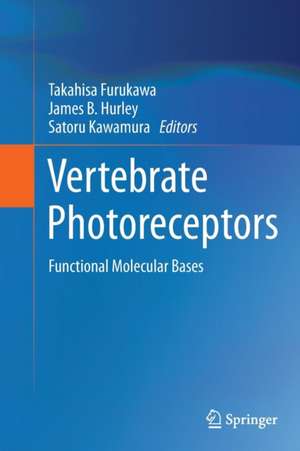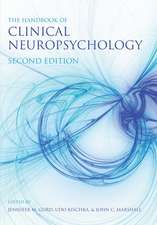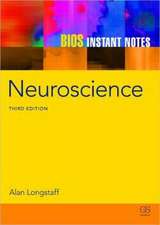Vertebrate Photoreceptors: Functional Molecular Bases
Editat de Takahisa Furukawa, James B. Hurley, Satoru Kawamuraen Limba Engleză Paperback – 22 aug 2016
Photoreceptors are the most deeply studied sensory receptor cells, but readers will find that many important questions remain. We still do not know how photoreceptors, visual pigments and their signaling pathways evolved, how they were generated and how they are maintained. This book will make clear what is known and what is not known. The chapters are selected from fields of studies that have contributed to a broad understanding of the birth, development, structure, function and death of photoreceptor neurons. The underlying common word in all of the chapters that is used to describe these mechanisms is “molecule”. Only with this word can we understand how these highly specific neurons function and survive. It is challenging for even the foremost researchers to cover all aspects of the subject. Understanding photoreceptors from several different points of view that share a molecular perspective will provide readers with a useful interdisciplinary perspective.
| Toate formatele și edițiile | Preț | Express |
|---|---|---|
| Paperback (1) | 947.50 lei 6-8 săpt. | |
| Springer – 22 aug 2016 | 947.50 lei 6-8 săpt. | |
| Hardback (1) | 959.19 lei 6-8 săpt. | |
| Springer – 29 apr 2014 | 959.19 lei 6-8 săpt. |
Preț: 947.50 lei
Preț vechi: 1155.48 lei
-18% Nou
Puncte Express: 1421
Preț estimativ în valută:
181.32€ • 196.89$ • 152.31£
181.32€ • 196.89$ • 152.31£
Carte tipărită la comandă
Livrare economică 23 aprilie-07 mai
Preluare comenzi: 021 569.72.76
Specificații
ISBN-13: 9784431563358
ISBN-10: 4431563350
Pagini: 360
Ilustrații: VIII, 349 p. 66 illus., 47 illus. in color.
Dimensiuni: 155 x 235 x 19 mm
Greutate: 0.5 kg
Ediția:Softcover reprint of the original 1st ed. 2014
Editura: Springer
Colecția Springer
Locul publicării:Tokyo, Japan
ISBN-10: 4431563350
Pagini: 360
Ilustrații: VIII, 349 p. 66 illus., 47 illus. in color.
Dimensiuni: 155 x 235 x 19 mm
Greutate: 0.5 kg
Ediția:Softcover reprint of the original 1st ed. 2014
Editura: Springer
Colecția Springer
Locul publicării:Tokyo, Japan
Cuprins
Chapter 1 Visual Pigments.-Chapter 2 Phototransduction in Rods and Cones.-Chapter 3 Visual Cycle.-Chapter 4 Adaptation.-Chapter 5 Energy Metabolism.-Chapter 6 Photoreceptor Development.-Chapter 7 Photoreceptor Synapse -- Synaptic Transmission.-Chapter 8 Photoreceptor Synapse -- Development of Synapse.-Chapter 9 Cell fate Determination.-Chapter 10 Polarity and Layer Formation.-Chapter 11 Photoreceptor Degeneration.- Chapter 12 Photoreceptor Regeneration.- Chapter 13 Pineal Organs.
Notă biografică
Takahisa Furukawa MD. Ph. D., Professor
Protein Institute, Osaka University, Osaka, Japan.
James B. Hurley, Ph. D., Professor
Department of Biochemistry, University of Washington, Seattle, USA.
Satoru Kawamura, Ph. D., Professor
Graduate School of Frontier Biosciences, Osaka University, Osaka, Japan.
Protein Institute, Osaka University, Osaka, Japan.
James B. Hurley, Ph. D., Professor
Department of Biochemistry, University of Washington, Seattle, USA.
Satoru Kawamura, Ph. D., Professor
Graduate School of Frontier Biosciences, Osaka University, Osaka, Japan.
Textul de pe ultima copertă
This book provides a series of comprehensive views on various important aspects of vertebrate photoreceptors. The vertebrate retina is a tissue that provides unique experimental advantages to neuroscientists. Photoreceptor neurons are abundant in this tissue and they are readily identifiable and easily isolated. These features make them an outstanding model for studying neuronal mechanisms of signal transduction, adaptation, synaptic transmission, development, differentiation, diseases, and regeneration. Thanks to recent advances in genetic analysis, it also is possible to link biochemical and physiological investigations to understand the molecular mechanisms of vertebrate photoreceptors within a functioning retina in a living animal.
Photoreceptors are the most deeply studied sensory receptor cells, but readers will find that many important questions remain. We still do not know how photoreceptors, visual pigments, and their signaling pathways evolved, how they were generated, and how they are maintained. This book will make clear what is known and what is not known. The chapters are selected from fields of studies that have contributed to a broad understanding of the birth, development, structure, function, and death of photoreceptor neurons. The underlying common word in all of the chapters that is used to describe these mechanisms is “molecule”. Only with this word can we understand how these highly specific neurons function and survive. It is challenging for even the foremost researchers to cover all aspects of the subject. Understanding photoreceptors from several different points of view that share a molecular perspective will provide readers with a useful interdisciplinary perspective.
Photoreceptors are the most deeply studied sensory receptor cells, but readers will find that many important questions remain. We still do not know how photoreceptors, visual pigments, and their signaling pathways evolved, how they were generated, and how they are maintained. This book will make clear what is known and what is not known. The chapters are selected from fields of studies that have contributed to a broad understanding of the birth, development, structure, function, and death of photoreceptor neurons. The underlying common word in all of the chapters that is used to describe these mechanisms is “molecule”. Only with this word can we understand how these highly specific neurons function and survive. It is challenging for even the foremost researchers to cover all aspects of the subject. Understanding photoreceptors from several different points of view that share a molecular perspective will provide readers with a useful interdisciplinary perspective.
Caracteristici
Integrates recent genetic, biochemical and physiological advances in the understanding of vertebrate photoreceptors
Highlights recent advances in understanding a neuronal system that is used widely as a model for many types of sensory transduction
Highlights the types of experimental approaches that have been most successfully used to advance the understanding of sensory systems
Includes supplementary material: sn.pub/extras
Highlights recent advances in understanding a neuronal system that is used widely as a model for many types of sensory transduction
Highlights the types of experimental approaches that have been most successfully used to advance the understanding of sensory systems
Includes supplementary material: sn.pub/extras

















